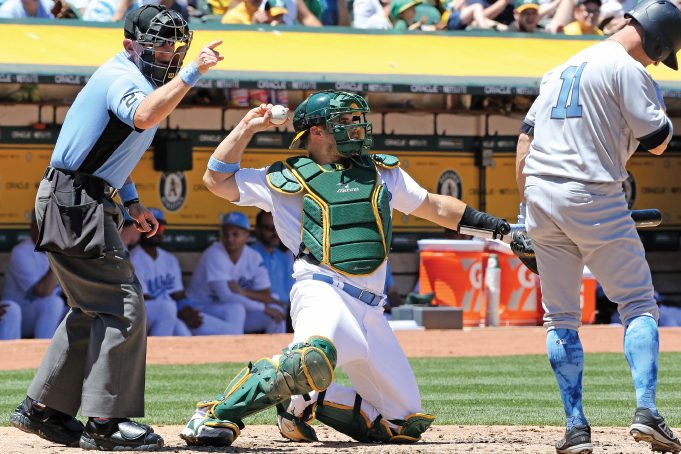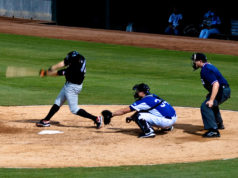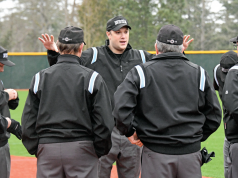With a new baseball season rolling along, here are a few tips and hacks involving plate work that can help you out as an onfield umpire. From long-time umpire and Referee magazine contributor Jon Bible.
1. When you receive the lineup cards at home plate, be sure they contain the proper number of players, correctly positioned. If a designated hitter is used, ensure that this is reflected. This kind of preventive action can eliminate a lot of confusion later on.
2. Get the home coach to go over the ground rules. It’s his park and he knows them better than you do, and it won’t detract from the authoritative image you want to project.
3. If there is a designated hitter rule, keep a laminated copy of it in your pocket and refer to it if needed. I did this several times, even in postseason play, and it always ended the discussion. I don’t buy the notion that an umpire should never trot out the rulebook on the field; if that is the only way to end a dispute and ensure that a rule is being properly applied, do it. I did this three or four times in my career and the pillars of society never did crumble.
4. At the start of the game, ask the catchers if their pitchers throw anything unusual. This will alert you to the unexpected — like pitches that break two feet — and it lets the catchers know you’re making an extra effort to prepare. People are more likely to stay off your back if they think you’re putting out 110 percent effort.
5. Get behind the catcher and take a few warmup pitches in the top and bottom of the first inning. You may not think you need to do this, but it sends a better message than if you just stand to the side and watch the pitchers throw.
6. Some umpires like to get acquainted with the catchers, thinking that a good rapport will make them less likely to gripe. Beyond saying hello and trading names, I chose not to talk with them very much. In fact, if I said five sentences to both over the course of nine innings, I had a very chatty day.
I got burned on this in pro ball in 1970. I had always been comfortable BS-ing with catchers, but one time I ended a game on a close call and later learned that on the team bus the catcher ripped me for yapping with him all night instead of concentrating on my job. That stuck in my craw, and from then on I was cordial with them but not talkative.
My attitude was that they have a job to do and so do I, and that my chattering with this captive audience (how many are going to tell you to shut up because you’re bothering them?) will only give them one more thing to throw in my face if things get rough during the game. Finally, too much back-and-forth between umpires and players is one of the coaches’ biggest pet peeves.
7. During your warmup pitches, think “TIMING.” Timing can make or break us on balls and strikes, and everyone sometimes has a problem with it. I remember one time that I realized I was calling pitches too fast when a partner got my attention and tapped his watch a couple of times, his signal for me to slow down. It helped.
Regarding timing, I would rather be too slow calling pitches than too fast. If my timing was right, I would pause at least a second after the pitch hit the mitt before I called it; this gave me a second look, and sometimes I would change my mind about a call before verbalizing it. Also, if you pause the same amount of time on every pitch, including the ones right down Broadway, no one will know you’re taking a second look. If, in contrast, you call most pitches quickly and then hesitate once or twice to take a good look, you can bet the next thing you’ll hear will be, “Make up your mind back there!”
8. Catchers today often position themselves far inside so that it can be difficult for us to see things. Sometimes you can ask them to move over and they will, but more often their reply will be that this is where they’ve been told to position themselves. Then we really don’t have any choice but to adapt. Don’t go over the catcher’s opposite shoulder, however, because you can miss a lot of things that happen, like a tight pitch that hits either the bat or batter’s hand; instead, go no farther than over the top of the catcher’s head.
9. Engage in preventive officiating if you can. If, for example, a pitcher is barely stepping to first base on pick-offs, you might tell the coach between innings that the step is borderline and that any less and you’ll have to balk him. Another example: “Coach, your catcher has developed a habit of holding pitches on me. Please take care of it so that I don’t have to.” One of the marks of a top-shelf umpire is the ability to sense trouble brewing and head it off calmly and unobtrusively. And I like to involve the head coach if I can — this way he has no gripe if trouble does develop and I have to deal with it my way.
Regarding balks, if you’re caught napping and miss one, as we’ve all done, tell the coach between innings that you let one slip by but you won’t miss it twice. When you don’t call a balk, you effectively tell the pitcher that what he did was OK; before nailing him the next time, put him on notice that his move was not OK and that the first miss was your error.
10. Don’t go to the mound to get a new pitcher’s name if you can avoid it. When a coach replaces a pitcher, chances are he’s upset with him, you or both of you. Why give him a close target to yell at? Get the name from the catcher, if you’re on speaking terms. Better yet, simply record the pitcher’s number on your lineup card. And position yourself on the baseline opposite the one that the departing pitcher will cross. It’s too easy for young, immature players to throw some blast your way if you’re standing three feet away from him as he walks by.
If you have to go to the mound because the coach has been there long enough and he then signals for a new pitcher, don’t stand there; back away to the foul line.
11. Avoid the dynamic strike-three signal which makes you do cartwheels. This can take your head out of the play so you wouldn’t, for example, see a batter interfere with a catcher trying to throw out a runner. It can also be construed as “showing up” the hitter and an effort to make yourself the center of attention, neither of which creates a good image. Strive for a firm, crisp but low-key signal which keeps you looking forward and does not make it seem like you’re enjoying ringing up the batter.
What's Your Call? Leave a Comment:
Note: This article is archival in nature. Rules, interpretations, mechanics, philosophies and other information may or may not be correct for the current year.
This article is the copyright of ©Referee Enterprises, Inc., and may not be republished in whole or in part online, in print or in any capacity without expressed written permission from Referee. The article is made available for educational use by individuals.



















